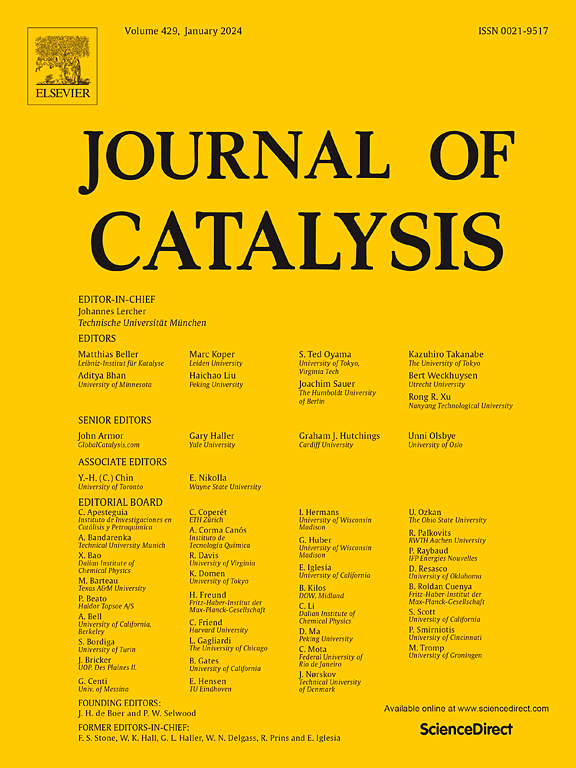Machine learning descriptors for CO activation on iron-based Fischer − Tropsch catalysts
IF 6.5
1区 化学
Q2 CHEMISTRY, PHYSICAL
引用次数: 0
Abstract
Due to the development of material synthesis and characterization technology, as well as limited computational resources, the understanding of CO activation on Fe-based Fischer − Tropsch synthesis (FTS) catalysts is still changing, making catalyst screening and rational design difficult. In this work, we propose a novel model that bridges the structure of common iron carbides (including o-Fe7C3, χ-Fe5C2, θ-Fe3C, η-Fe2C and ε-Fe2.2C) with their CO activation capability. Using spin-polarized density functional theory (DFT), we explored CO activation pathways on a series of defective o-Fe7C3 surfaces. Advanced machine learning (ML) algorithms suitable for small datasets were employed to construct descriptor formulism with high predictive power for CO dissociation barriers. The ML-derived descriptor formulism unifies the catalytic expressions of various iron carbide phases, emphasizing the crucial roles of work function, carbon-vacancy formation energy, CO adsorption energy, coordination number, and the size of reaction sites in the CO dissociation process. This approach provides a deeper understanding of catalytic performance of distinct iron carbide surfaces and is applicable for designing high-performance catalysts for FTS, thereby accelerating catalyst development. Furthermore, the strategy for identifying descriptors with a limited dataset highlights the potential of combining DFT and ML methods.


铁基fischer催化剂上CO活化的机器学习描述符 − Tropsch催化剂
由于材料合成和表征技术的发展,以及有限的计算资源,对fe基Fischer − Tropsch合成(FTS)催化剂上CO活化的认识仍在变化,这给催化剂的筛选和合理设计带来了困难。在这项工作中,我们提出了一个新的模型,将普通碳化铁(包括o-Fe7C3, χ-Fe5C2, θ-Fe3C, η-Fe2C和ε-Fe2.2C)的结构与它们的CO活化能力联系起来。利用自旋极化密度泛函理论(DFT),我们探索了CO在一系列缺陷o-Fe7C3表面上的活化途径。采用适用于小数据集的先进机器学习(ML)算法构建具有高预测能力的CO解离屏障描述符公式。ml衍生的描述子公式统一了各种碳化铁相的催化表达式,强调了功函数、碳空位形成能、CO吸附能、配位数和反应位点大小在CO解离过程中的关键作用。该方法提供了对不同碳化铁表面的催化性能的更深入的了解,并适用于设计Fischer − Tropsch合成(FTS)的高性能催化剂,从而加速催化剂的开发。此外,用有限数据集识别描述符的策略突出了DFT和ML方法相结合的潜力。
本文章由计算机程序翻译,如有差异,请以英文原文为准。
求助全文
约1分钟内获得全文
求助全文
来源期刊

Journal of Catalysis
工程技术-工程:化工
CiteScore
12.30
自引率
5.50%
发文量
447
审稿时长
31 days
期刊介绍:
The Journal of Catalysis publishes scholarly articles on both heterogeneous and homogeneous catalysis, covering a wide range of chemical transformations. These include various types of catalysis, such as those mediated by photons, plasmons, and electrons. The focus of the studies is to understand the relationship between catalytic function and the underlying chemical properties of surfaces and metal complexes.
The articles in the journal offer innovative concepts and explore the synthesis and kinetics of inorganic solids and homogeneous complexes. Furthermore, they discuss spectroscopic techniques for characterizing catalysts, investigate the interaction of probes and reacting species with catalysts, and employ theoretical methods.
The research presented in the journal should have direct relevance to the field of catalytic processes, addressing either fundamental aspects or applications of catalysis.
 求助内容:
求助内容: 应助结果提醒方式:
应助结果提醒方式:


